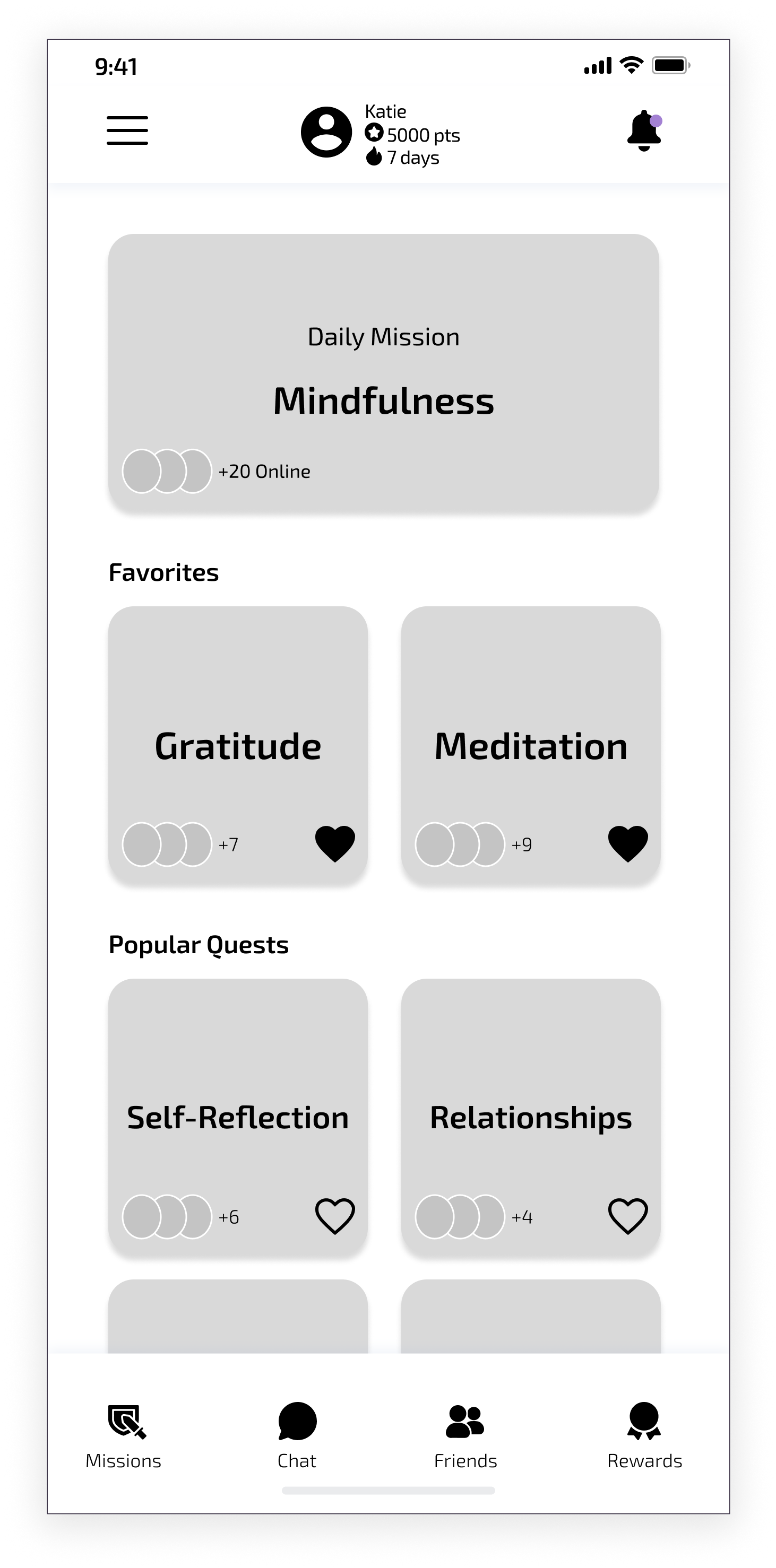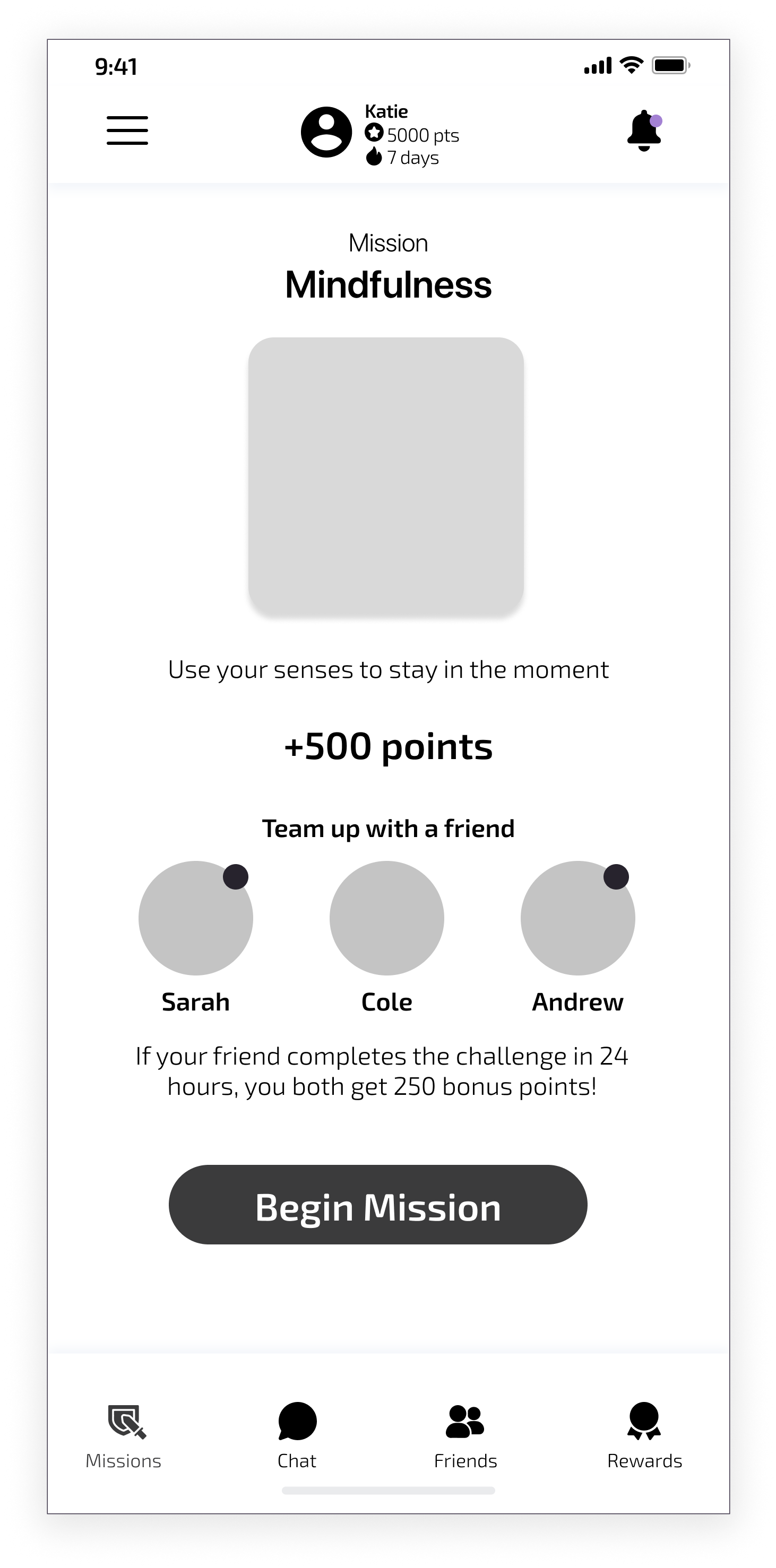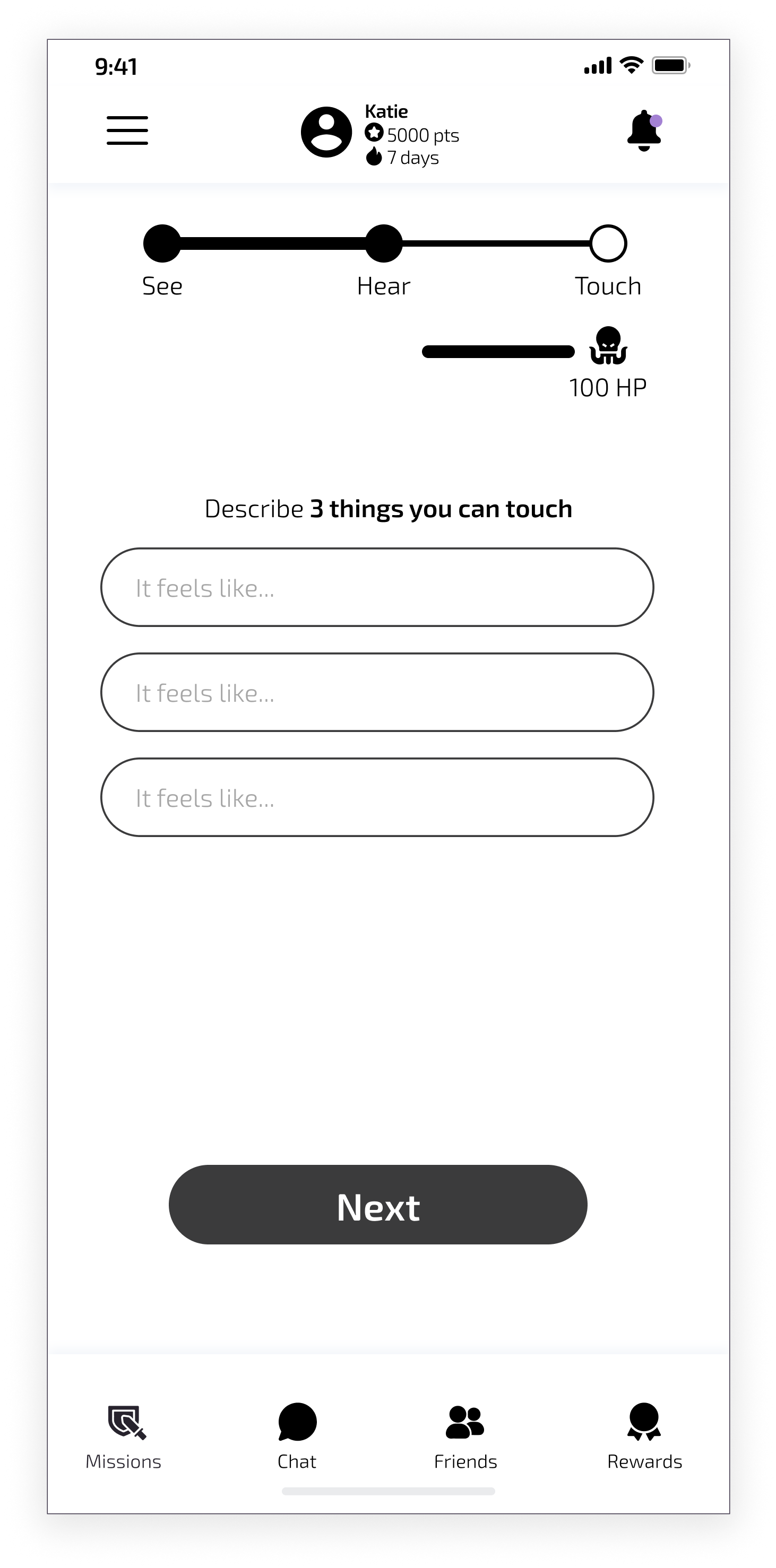
I SEE MYSELF
Improving mental wellness for Gen Zers through gamification
MY ROLE: Research, UX and UI TIMELINE: 4 weeks
INTRODUCTION
I See Myself is an early-stage startup mental health app that personalizes, gamifies, and socializes wellness for Gen Zers. At the time, they had conducted research and established the basics of their user interface.
Our team stepped in to improve their Minimum Viable Product (MVP), and utilized research and analysis from their previous design to further refine a gamified user experience.
PROBLEM
Because of the pandemic's isolation and unpredictability, mental health has become increasingly important, however it can be a difficult discussion to address and taking care of one's mental health can be challenging. Current applications are oriented for the millennium demographic and focus on one activity and passive care. The goal was to design an app that would allow users of the Gen Z demographic to incorporate positive psychology activities into their daily lives in order to preserve mental wellbeing.
TEAM
Sree Kathiravan - CEO
Contractors:
Vanina Trogolo - UI/UX Designer
Ryan - UI/UX Designer
Mei - UI/UX Designer
Charlie - UI/UX Designer

BUSINESS GOAL
RPG-style mobile gaming app that will use empirically backed happiness quests.
Their goal is to solidify a design solution that could gear the product towards the Gen Z population that would be:
A fun product that motivates continual use
Focuses on mindfulness reasoning and tasks to complete exercises with rewards or incentives for points
Has a messaging function that promotes vulnerable conversations outside of quest activities
MY ROLE
In collaboration with a team of 4 designers, I:
Conducted research on mindfulness activities
Iterated and expanded upon their current screen designs for the initial user flows
Developed lo-fi wireframes and high fidelity mockups
Created a mindfulness quest with teammates playing alongside each other
Produced a prototype

SOLUTION
Using gamified happiness principles to improve overall well-being and motivate continual use
Group Games
Gamified happiness tenets to level up your wellness
Opportunity to do different daily quests
Grouping different positive psychology tasks by category
Learn happy habits through content library
1
Accountability Partners
Team up with friends for bonus points
Increase chances of accomplishment up to 95*
Accountability partners provides source of intrinsic motivation
*according to the American Society of Training and Development
2
Sense of Community
Get motivated by your social network
Chat messaging feature to engage with teammates
Know when friends are online
Options to type, record voice, and attach images
3
RESEARCH
Gen Z is going through a mental health crisis with loneliness as a key factor [1]
Our first task in improving I See Myself's MVP was to dive into their ethos, business goals, existing research, and project documentation. Their goals are based on the following:
With those insights, the 3 major tenants of I See Myself are:
Foster Social Connections
✔
Alleviate Anxiety
✔
Encourage Happy Habits
✔
COMPETITIVE ANALYSIS
Key finding 1 - Gamification feature missing from most wellness apps
A comparative research was provided by the client to establish the features that make mental wellness apps on the market effective and help in users' mental wellbeing.
WHITE PAPER RESEARCH
A way to achieve goals with 95% success…
While researching the topic of goals, motivation, and achievement, I came across this eye-opening statistic from the American Society for Training and Development:
“..people are 65 percent likely to meet a goal after making their goal public. But their chances of success increase to 95 percent when they have a specific accountability partner to report to”
Key finding 2 - The competition had no ACCOUNTABILITY aspect
Considering the above statistic, I also examined these popular apps surrounding the goal/productivity space. In my research I found none of them had an accountability partner to motivate or help the user reach their goals. This presented an opportunity for me to include a team players option for an accountability aspect in the solution.
PERSONA
The startup had previously conducted interviews with potential users and the persona that was determined from those findings was factored into our design. They found that almost every potential user stated they didn’t rely on parents as a support system. Discussions about mental health with family members were generally less popular than discussions with friends. This information created the opportunity to add group activities and messaging that would allow for vulnerable conversations and relationship building.
In creating a Gen Z persona, their primary user group was a student transitioning from high school to college and experiencing some mental health challenges, where the coping strategies they had used in the past resulted inadequate for them. In order to effectively target Gen Z, we must adapt our wellness strategy to accommodate their familiarity with smartphones, as these devices have been in their hands for most of their lives.
A product that would help Katie learn new habits and maintain her mental wellness in check
USER FLOW
Defeating the Stress Serpent - Main feature flow of completing a mission
Based on our team’s brainstorming session, we started moving the needle in terms of incorporating a role playing game by using mindfulness reasoning and tasks to complete an exercise, while earning rewards and incentive for points.

LO-FI WIREFRAMES
Game Element - Completing mindfulness actions as a pathway to moving the story forward and staying present
The low fidelity screens were designed based on a mindfulness quest, where users were asked to record three things they saw, heard, and touched. This quest aimed to promote mindfulness by encouraging users to stay in the present moment, and it provided an excellent opportunity to integrate unique features and encourage communication among friends.

VISUAL DESIGN
Keeping with the client's preference
We stayed with the client’s preferred astronaut theme while including some space elements to align with the brand's feel. Keeping a friendly and approachable style in combination with a space theme, we chose a font that is futuristic but readable.
MOBILE APP DESIGN
Applying the visual design to the wireframes… and a few iterations
We iterated on the initial design and made some slight updates to the wireframes after discussing including a condensed instructions page, and separation of the streak and points icons on the top bar to reduce clutter. We also removed the user’s name in top bar since the profile icon serves the same purpose.
New features aimed at enhancing team dynamics were also introduced with the high fidelity screens. The introduction of a messaging interface would enable both typed and audio messages to be sent during a quest. It was also now possible for team members to see what each other had completed as part of the tasks, and quests could not be completed without all team members completing each step. As a result of these improvements, users should feel as if they are truly on a quest with their friends, working together and holding each other accountable. Our main goal being to give an overall sense that these types of discussions are not only acceptable, but encouraged.
Happy Habits ✔
Maintain Wellness ✔
Stay Connected ✔

REFLECTIONS
As someone who is always looking to expand my horizons in the UX space to advance my knowledge in the field, I See Myself’s mission greatly resonated with me and it was exciting to be a part of this Gamification MVP improvement project. This exposure to gamification in UX gave me the opportunity to use the technique of inserting game mechanics into non-game products, and it taught me the potential it has to influence, motivate users to achieve tasks, and increase people's engagement. Using game elements to tell a story around what players are doing as my first start-up was fascinating.
NEXT STEPS
As they were still in the early stages of their business, many aspects of their brand and product were not fully formed, and their time and resources were limited. A full product could not be completed due to the time constraint and scope of the project, so the next step would be to develop a product that included:
Conducting Usability testing
Creating more storyline / game quests
Iterating designs so they are seamless and ready for development hand off












